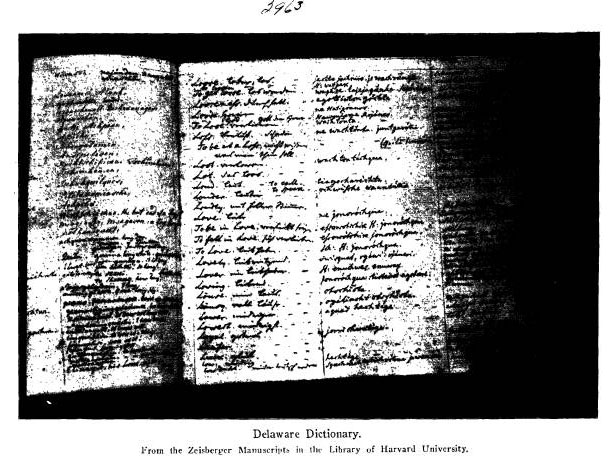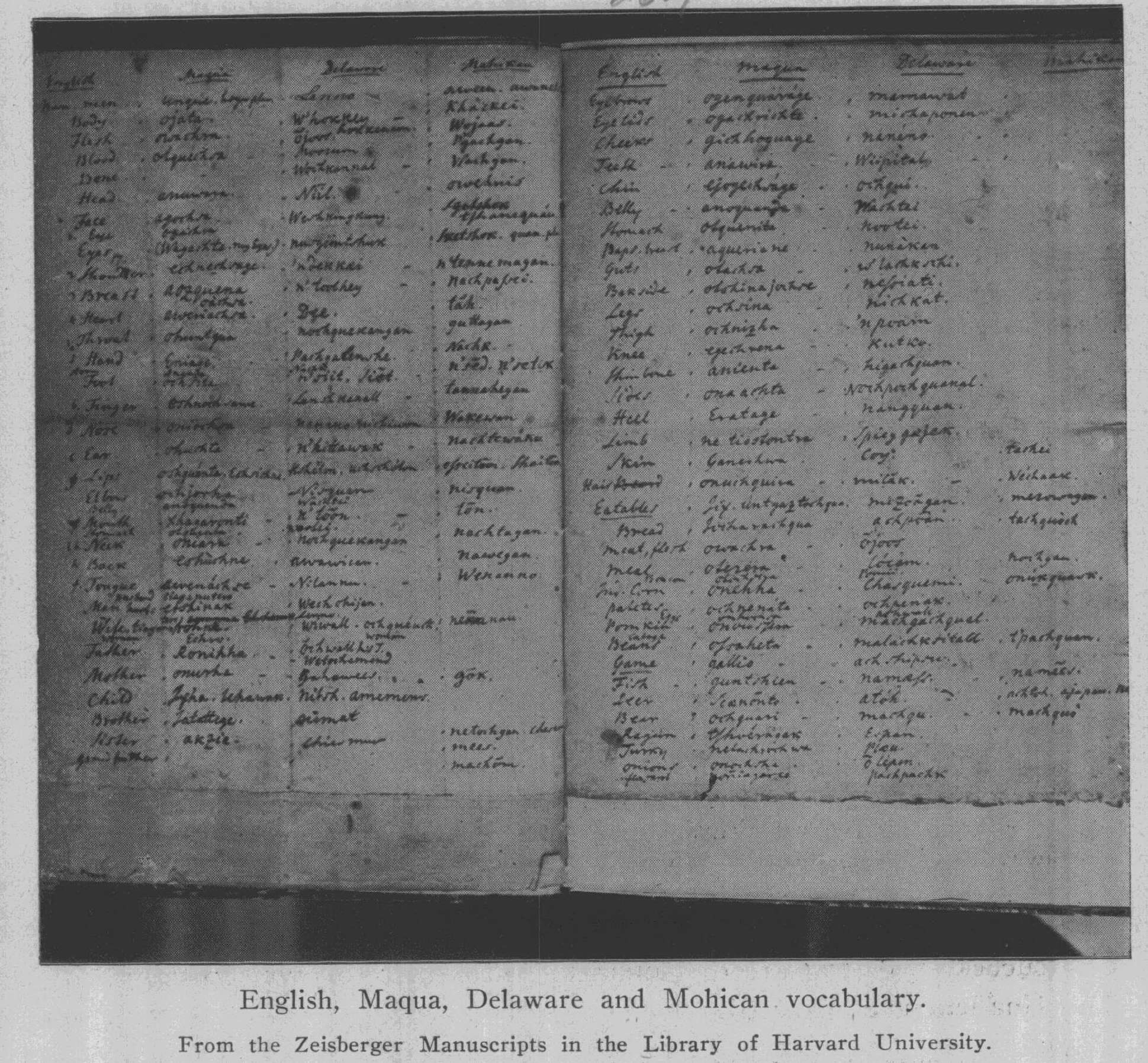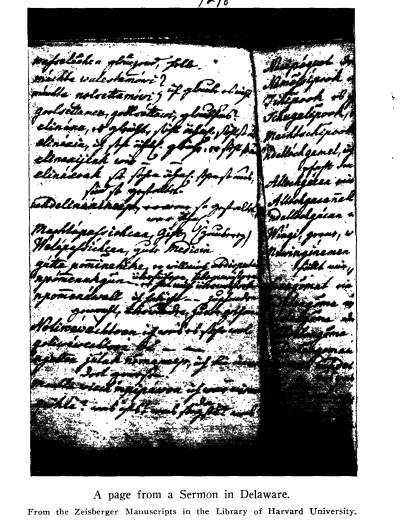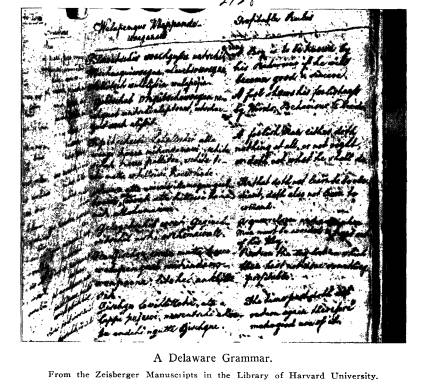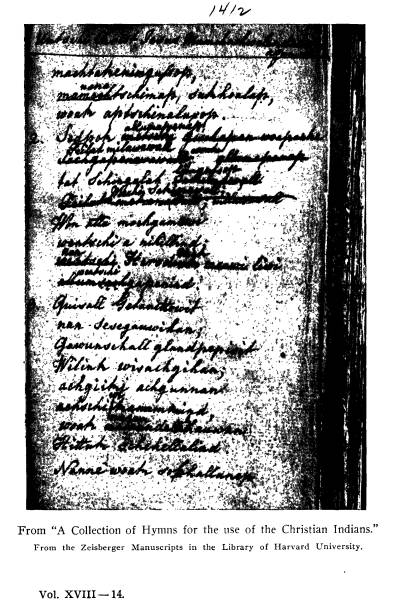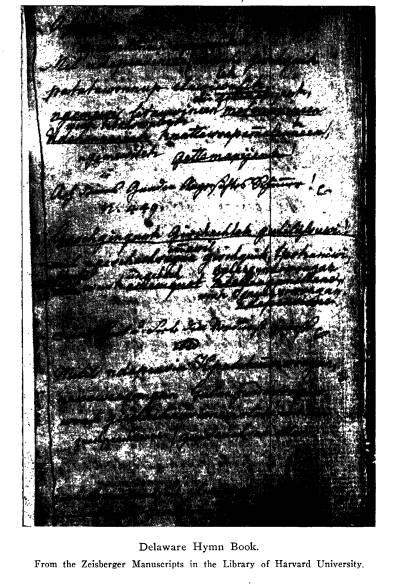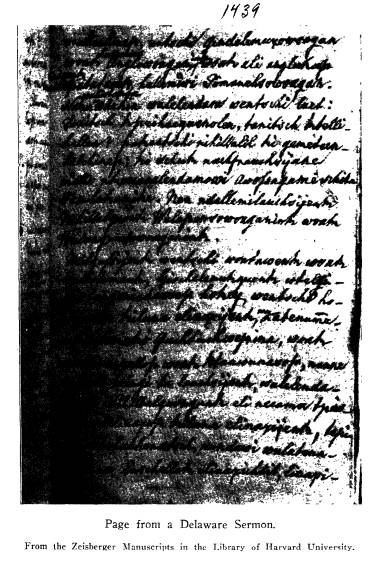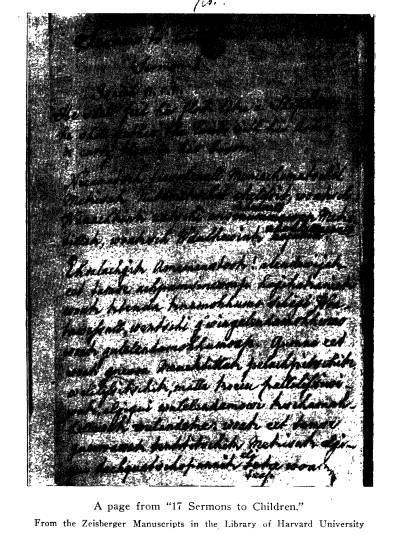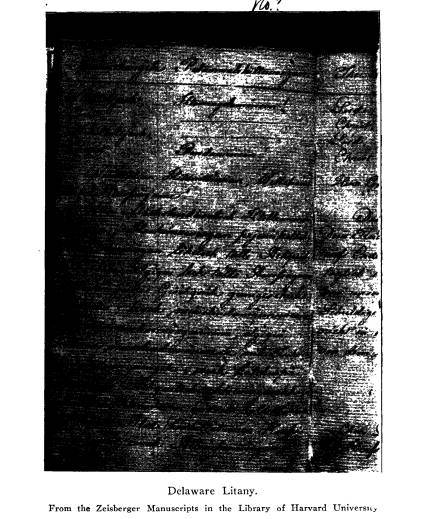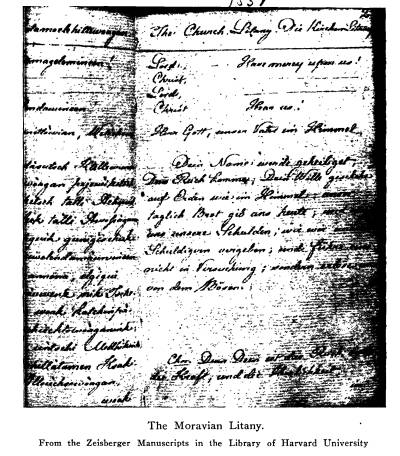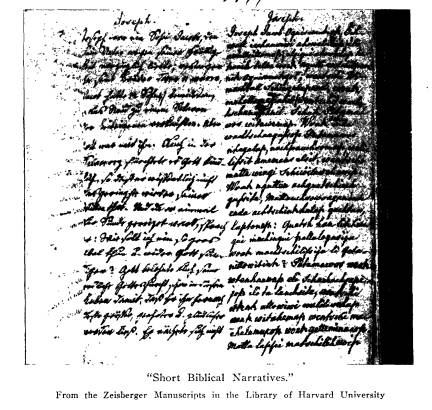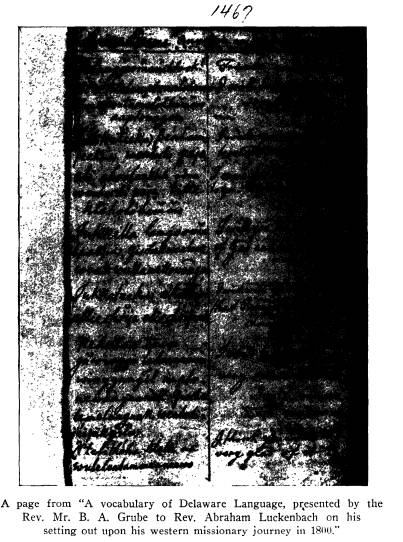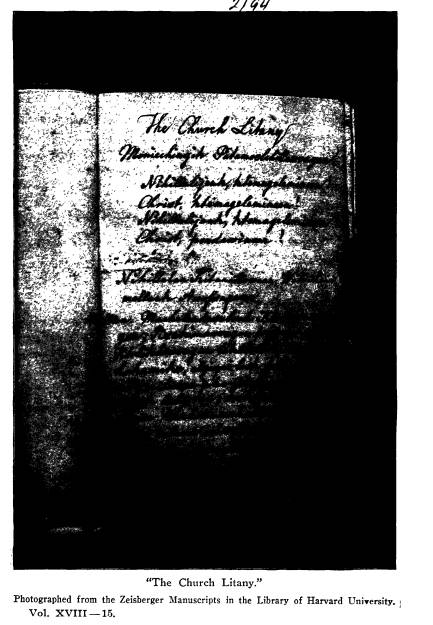Ohio History Journal
190
Ohio Arch. and Hist. Society
Publications.
I. HIS DECISIVE CONVERSION.
David Zeisberger's conversion stands out
as clearly and
strongly as does that of John Wesley. in
January, 1743, a lit-
tle company stood on the deck of the
"James," ready to leave for
Europe. It was a group of Moravian
Brethren, most of whom
had come to take leave of their beloved
leader, Count Zinzen-
dorf. Belonging to this company was a
young man, twenty-
two years of age, who had been appointed
to return with the
Count to Germany. He stood alone and
looked mournfully
upon the land of his choice. "Cast
off the cable!" commanded
Captain Garrison. At that moment Bishop
Nitschmann, who
had been the last to take leave of Count
Zinzendorf, passed by,
and, observing the young man's dejected
looks, stopped short.
"David," said he, "do you
not return to Europe willingly?"
"No, indeed!" was Zeisberger's
reply. "I would much
rather remain in America."
"For what reason?"
"I long to be truly converted to
God and to serve Him in
this country."
This declaration deserves our careful
consideration. David
Zeisberger was a "born
Moravian" both nationally and denomi-
nationally. His birthplace was
Zauchtenthal in Moravia, where
he first saw the light of day on Good
Friday, April II, 1721.
His parents belonged to the Ancient
Church of the Bohemian
and Moravian Brethren. They were
evidently most godly peo-
ple, for in July, 1726, they left their
large earthly possessions,
forsaking all for Christ's sake, and
sought a refuge in the new
settlement in Saxony called Herrnhut.
And yet, born Moravian
that Zeisberger was, and brought up in a
pious home, he him-
self apparently remained unchanged by
the Divine grace and
Spirit. Heredity was not sufficient. Not
that he despised his
birthright; far from it! He prized his
privileges and oppor-
tunities. With the great Scotch preacher
and poet, Horatius
Bonar, he would have said:
"I thank Thee for a holy ancestry;
I bless Thee for a godly parentage;
For seeds of truth and light and purity,
Sown in this heart from childhood's
earliest age."
David Zeisberger. 191
Another circumstance to be noted is
this: David Zeisberger
passed through the great revival of 1727
and the following years
in Herrnhut. Ten years he spent in that
place of which John
Wesley wrote: "God has given me at
length the desire of my
heart. I am with a church whose
conversation is in heaven, in
whom is the mind that was in Christ, and
who so walk as He
walked." In this congregation David
Zeisberger lived during
the most impressionable years of a
person's life, from five to
fifteen, and yet without being
"converted to God." He
listened
to the strong Scriptural preaching of
the Moravian carpenter,
Christian David; he heard the joyful
testimonies of that "little
preacher of righteousness,"
Susannah Kuehnel; he witnessed
the remarkable prayer-meetings of the
children when they spent
hours in supplication and praise; yet,
though deeply impressed
by all he saw and heard, there was in
his case no definite de-
cision, no absolute surrender. He still
was not "converted to
God."
Let us learn from this that neither heredity
nor environment
can save a soul. Zeisberger's
opportunities were certainly of
the best. Pious Moravian parentage,
godly Moravian training
and education were all enjoyed by him,
and not without much
profit. It is a matter of record that he
was the "brightest Latin
scholar of his class, a diligent student
who showed a natural
facility for acquiring languages."
Moreover, he lived a morally
pure and clean life. He was a truthful,
honest and industrious
lad. The first year spent in America,
1739, he acted as a trav-
eling companion and assistant of Peter
Boehler, that masterful
preacher and soul-winner, just arrived
from England, where he
had been the means in the hand of God
for the conversion of
hundreds, among them being John and
Charles Wesley. With
him David Zeisberger spent upwards of a
year and yet was not
"converted to God." In later
years when speaking of this period
of his life he said: "At that time
my heart was not yet con-
verted to God, but I longed to enjoy His
grace and that fully."
On board the vessel, therefore, Bishop
Nitschmann advised the
young man to leave the ship and return
to Bethlehem. Zeis-
berger did not wait to be told a second
time. He returned to
Bethlehem in a state of deep spiritual
concern and of longing
192
Ohio Arch. and Hist. Society Publications.
for the assurance of the pardon of his
sins. A Brother by the
name of Buettner, four years his senior,
acted the part of An-
drew and Philip in bringing the young
man to Jesus. "Some
days thereafter, during the singing, by
a company of young men
in the Single Brethren's House at
Bethlehem, of a familiar hymn
of praise to Jesus, the Saviour of
sinners, a great light came
into his soul, and Zeisberger
realized the joy of thorough con-
version in the assurance that the
Saviour had taken all his sins
away."
This great change was such a distinct
and unique experi-
ence in his life that Zeisberger might
truly with few variations
have adopted John Wesley's words, who
described his own con-
version at a little Moravian meeting in
London as follows:
"About a quarter before nine, while
he was describing the change
which God works in the heart through
faith in Christ, I felt my
heart strangely warmed. I felt I did
trust in Christ, Christ
alone, for salvation; and an
assurance was given me, that He
had taken away my sins, even mine, and
saved me from the law
of sin and death."
II. HIS EVANGELISTIC ZEAL.
David Zeisberger at once became an
evangelist. The old
martyr-spirit of the Ancient Bohemian and
Moravian Church
was both in name and in fact the
"witness-spirit" of the Re-
newed Brethren's Church. Zeisberger put
at once into practice
what another young Moravian in Europe
was doing at the same
time, viz., John Cennick, who testified:
"Then will I tell to sinners round
What a dear Savior I have found,
I'll point to the atoning Blood
And say: Behold the way to God!"
Zeisberger, like his Master, practiced
both personal and
public evangelism. In John's Gospel,
chapter 4, we are told
how Jesus dealt with one poor sinner in
such a way as to lead
her to repentance and faith. This might
be called personal
evangelism. It led into a larger field.
This woman became
such a witness, that Christ was invited
to spend several days
David Zeisberger. 193
in her town, and to conduct there a
public evangelistic campaign
resulting in the conversion of hundreds.
Some one has called
it "The Revival at Sychar."
Following in the footsteps of the
Savior, young Zeisberger
felt his heart drawn out in pity towards
the lowest and poorest
of mankind. He began to speak to some
Indians near Bethlehem
and Nazareth of "Jesus and His
love." Proceeding further
through the wilds of Pennsylvania he
preached to the Indians in
the Mohawk Valley of New York. When he
and a brother-
missionary were arrested as spies and
asked by Governor Clinton
at Albany, N. Y., as to their designs,
they made this truly
Moravian and Scriptural reply: "We
hope to get liberty to
preach among the Indians the Gospel of
our Crucified Savior,
and to declare to them what we have
personally experienced of
His grace in our own hearts." This
became the supreme pas-
sion of his life-"to declare to the
Indians what he had per-
sonally experienced of Christ's grace in
his own heart." In
order to do this, he mastered their
languages and dialects, tran-
lated the Holy Scriptures. Litanies and
Sacred Songs, prepared
school-books, grammars, dictionaries,
etc., and spent sixty-three
years of his life amongst his brown
brethren, often in pathless
forests, frequently exposed to
privations, hardships and death,
all with one object in view, viz.,
"to declare to them what he had
personally experienced of Christ's grace
in his own heart." He
became a plodding student, a thorough
scholar, a famous lin-
guist, a noted writer, an accomplished
administrator, in order
that he might be a successful
evangelist. Frequent revivals ac-
companied his faithful testimony.
The famous picture of Zeisberger preaching
to the Indians
well illustrates the supernatural power
of the Gospel which he
preached "with the Holy Ghost sent
down from heaven" At
one time when laboring in Central
Pennsylvania Zeisberger
wrote:
"For several months a great revival
has been prevailing
among the Indians who visit us. All who
attend our services
are deeply impressed and listen as
though they never had enough
of the message of the Savior. Often
while I am preaching the
power of the gospel message makes them
tremble with emotion
Vol. XVIII-13.
194
Ohio Arch. and Hist. Society Publications.
and shake with fear, until they almost
lose consciousness and
seem about to faint. This shows with
what violence the powers
of evil within them oppose the work of
the Cross. As a rule
when such a paroxysm is over they weep
in silence."
Special methods and meetings were found
to be necessary
in dealing with those under conviction
of sin. Zeisberger's
biographer tells us; "A revival
broke out at the new mission,
named Friedenstadt, in Western
Pennsylvania. In the house
of Abraham, the Helper, inquiry meetings
were held every even-
ing, sometimes lasting until midnight.
Even the children were
impressed and talked of Jesus." St.
Paul's maxim or rule of
methods had evidently been adopted by David
Zeisberger: "By
all means save some." Like Alleine he was "insatiably greedy
after souls." With David Brainerd
he could say: "I had no
notion of joy from this world; I care,
not where or how I live,
or what hardships I went through, so
that I could but gain
souls for Christ."
Brainerd finished his course with joy
after five years' service;
Zeisberger toiled in the vineyard
sixty-three years. A biographer
thus describes one of his many journeys:
"For two days, amid
drenching rain, in the pathless forests
and swamps of the Broad
Mountain, in what is now Monroe County,
these two mes-
sengers of Jesus crept for miles on
hands and feet, beneath and
between laurel bushes whose tangled
mazes made walking im-
possible. Their only guide was a pocket
compass. After two
days they struck the trail to Wyoming.
Although thoroughly
exhausted by the toil of their journey,
Zeisberger at once began
to preach the gospel. The Indians
flocked from every side to
hear his blessed message. Next morning,
after a short night's
rest, the work was resumed, and for
three days he preached
Christ with great power. Tears rolled
down the cheeks of his
hearers and their whole frames were
convulsed with emotion."
"He is wise that winneth
souls," said Israel's royal sage,
and David Zeisberger was indeed a wise
soul-winner, for, like
John Wesley, he organized the newly
converted into societies
and drew up rules and regulations for
their guidance. One of
two articles of their "brotherly
agreement" may well be heeded
in thesetimes:
David Zeisberger. 195
"We will rest from work on the
Lord's day and attend
public service."
"We will have nothing to do with
thieves, murderers,
whoremongers, adulterers or drunkards.
We will not take part
in dances, sacrifices, heathenish
festivals or games."
"We will not admit rum or any other
intoxicating liquor
into our towns. If strangers or traders
shall bring intoxicating
liquors, our Helpers shall take it from
them and not restore
it until the owners are ready to leave
the place."
No wonder in view of all this that one
of Zeisberger's ad-
mirers exclaims: "Rich fruitage of
the veteran missionary's life
labor! Happy indeed amid all the
countless trials and poignant
sorrows that clouded his career, in the
triumph of the Savior's
grace over the powers of darkness, in
the salvation of hundreds
and thousands of precious souls!"
III. HIS TRIUMPHANT DEATH.
A century ago this valiant soldier of
the Cross stood face
to face with "the last enemy."
In spirit let us gather around
that death-bed. The historian tells us:
"Zeisberger lay calm,
without pain and perfectly conscious.
The converts sang hymns,
treating of Jesus, the Prince of Life,
of death swallowed up in
victory, and of Jerusalem, the Church
above. He occasionally
responded by signs expressive of his joy
and peace. Amid such
strains, at half past three o'clock in
the afternoon, he breathed
his last, without a struggle, and went
to God. All present im-
mediately fell on their knees."
"Oh may I triumph so,
When all my warfare's past;
And dying find my latest foe
Under my feet at last!"
What now was the secret of Zeisberger's
peace in death, of
his victory over the mighty conqueror?
What-was the ground
of his serene confidence? Did he rest on
his own achievements?
He might with reason have been tempted
to do so. What a
career could he look back upon! Measured
by length of service,
by absolute consecration to Christ, by
self-denial and self-sacrifice
196
Ohio Arch. and Hist. Society Publications.
for the sake of the gospel, no name
stands higher in the history
of Christian Missions than that of David
Zeisberger. With the
Apostle Paul he might have said: "Are they ministers of
Christ?
(I speak as a fool) I am more; in labors more
abundant, in prisons more frequent, in
deaths oft. In journey-
ings often, in perils of waters, in
perils of robbers, in perils
by mine own countrymen, in perils by the
heathen, in perils in
the wilderness. In weariness and painfulness, in watchings
often, in hunger and thirst, in fastings
often, in cold and naked-
ness." II Cor. II:23-27. Yet all
these toils, trials and suffer-
ings, so cheerfully borne for Christ's
sake during nearly seven
decades, did not form Zeisberger's
ground of confidence in the
hour of death.
Was it then perhaps his seemingly
perfect character? To
us at this distance as well as to his
contemporaries David Zeis-
berger appears well-nigh faultless. His
famous companion in
labors, John Heckewelder, said of him:
"He was endowed with
a good understanding and a sound
judgment; a friend and
benefactor of mankind, and justly
beloved by all who knew
him, with perhaps the exception of those
who were enemies of
the Gospel which he preached."
"Experience invariably proved
the correctness of his judgment.
Receiving, as it were, a glimpse
of the future, through the deep thoughts
and silent prayers in
which he engaged, he stood up, on most
occasions, full of con-
fidence and knew no fear." "He
would never consent to have
his name put down on a salary-list or
become a 'hireling,' as he
termed it; saying that although a salary
might be both agree-
able and proper for some missionaries,
yet in his case it would
be the contrary."
The language used by the noted Unitarian
preacher, Theo-
dore Parker, in his eulogy of the famous
missionary, Adoniram
Judson, might with equal truth be
applied to David Zeisberger:
"If the Foreign Missionary
enterprise had accomplished nothing
more than to produce such a character it
had been well worth
all its costs and sacrifices."
But Zeisberger's hope for eternity was
built on a better and
stronger foundation than that of his
wonderful character. A
few days before his death he gave his
last testimony, and the
David Zeisberger. 197
words form the, sum and substance of his
creed and experiences:
"As my weakness is continually
increasing and my appetite gone,
I believe that the Saviour intends to
take me to Himself. Ly-
ing here, often sleepless, on my bed, I
have employed the time
in reviewing my whole past life, and I
find so many faults,
and so much cause for forgiveness, that
nothing remains to me
but His grace. Nevertheless I know that
I am His. I trust
in the efficiency of His atoning blood,
which makes one clean
from all sin. The Saviour is mine. The
Saviour's merits are
mine. Some Christians die rejoicing,
with joy unspeakable and
full of glory. This is not my case. I
leave the world as a poor
sinner. My spirit God will receive. I am
certain of that. This
mortal, with all its sinfulness, I leave
behind."
And thus the greatest of Moravian
missionaries passed into
the presence of the King and entered the
joy of his Lord. The
Christian Church does well to observe
the Centennial of his
death. We, of this place, would
affectionately call to mind the
heroic youth who helped to found our
town and congregation.
Often has he trod this ground on errands
of mercy for his
Master. How times have changed! The very
soil which his
weary feet frequently pressed has become
a source of untold
material wealth. Where nestled some of
his mission-stations
huge cement plants are now located. But
his name and fame
are far more imperishable even than the
products of those great
industries. The wild mountain regions of
Pennsylvania which
he so willingly traversed on foot for
many years, searching out
and shepherding his brown brethren, for
whom Christ died, have
yielded up incalculable treasures of
coal, iron and oil, and made
some of his fellow mortals
multi-millionaires and "kings of
finance;" but none of them can for
a moment compare with him
who coveted only "souls for his
hire and as seals of his ministry."
The Territory of Ohio, in which he
achieved some of his
mightiest missionary triumphs, has
become a great State, and
the so-called "mother of
presidents;" but the fame of none of
them will equal his who a century ago
left her clime for the
Paradise of God, who having "turned
many to righteousness
shall shine as the stars for ever and
ever."
Let us not, however, spend our lives and
waste our breath
198 Ohio Arch. and Hist. Society Publications.
in mere idle admiration, but let us
follow him even as he followed
Christ. Be it ours to seek and find that
"full assurance" of our
pardon in the "precious
blood;" be it ours to bear witness "to
sinners round" of what "we
have personally experienced of
God's grace in our own hearts;" be
it ours to turn our backs
upon the world with its treasures and
pleasures, "to seek and
to save the lost;" in order that
there may be said of us what
was so truthfully affirmed of David
Zeisberger in the text of his
funeral sermon a century ago: "They
overcame by the blood
of the Lamb, and by the word of their
testimony, and they loved
not their lives even unto death." (Rev. 12:11.)
"Soldier of Christ, Well done!
Thy glorious warfare's past!
The battle's fought, the victory won,
And thou art crowned at last!"
THE MORAVIAN RECORDS.
ARCHER BUTLER HULBERT
Professor of American History,
Marietta College; Editor Washington's
Tour of the Ohio 1770, Washington's
Journal of 1784, The Crown
Collection of American Maps, etc.
[A portion of an address given at the
Zeisberger Centennial, No-
vember, 1908. For the accompanying
illustrations thanks are due William
C. Lane, Librarian of Harvard University
in which the original manu-
scripts were deposited by Edward Everett
who collected them.]
I think Zeisberger's service was most
marvelous for his sub-
lime patience, and the addresses of Dr.
Rice and others during
the centennial proceedings have shown us
that when that patience
failed, the great heart of Zeisberger
failed also. I almost feel
that Zeisberger would have died at any
time when that sublime
patience had reached its limit of
endurance. The Bible, you
know, tells us that it is for some to
"mount up with wings
like eagles, they shall run and not be
weary, the shall
walk and not faint." It was for
some to mount up with wings
like eagles in that great unfolding
drama that wrought a new
civilization in the twilight of this
American Black Forest be-
tween the Allegheny and the Wabash; it
was for some to run
and not be weary - men who also laid
potent hands on the
mysterious forces which in God's
providence were to produce
great empires where the deer loved to
play among these trees;
and then there were men who were merely
to walk and not faint,
not to do the conspicuous. things or
appear in notable affairs
but to whose hands came a host of
commonplace, monotonous
duties - lives not woven in white and
purple but in "one seam-
less stuff of brown." Such was the life of the man we bear in
mind today and as such it is of pregnant
inspiration - or should
be - to all of us who must be humdrum
heroes, trying our best
to walk and not to faint.
Since 1898 when I attended the
Cnadenhutten Centennial, I
199
The Moravian Records. 201
have had more than a passing interest in
the work of the Morav-
ian missionaries but it was only very
lately that it became plain
how tremendously we are in the debt of
those fearless men for
the preservation of the early history of
this middle west and of
Ohio in particular.
Last summer under the auspices of the
Ohio State Archaeo-
logical and Historical Society was began
a thorough examination
of what we may for convenience call
"The Moravian Records"
at Bethlehem with the generous aid of
Professor Schwarze, of
the Moravian Theological Seminary. The
lack of any list or
calendar of the immense collection of
documents there made it
impossible to determine its historical
value. From the appended
catalogue, rough and brief as it is, it
will appear that it is un-
likely that any other source is more
prolific of information con-
cerning the regions in which the
Moravians operated than these
collections at Bethlehem will untimately
prove to possess. The
Moravians were assiduous and careful
record keepers; every
mission congregation kept its daily
record; all affairs came in
for mention in these diaries, secular
and religious. At times they
are given up entirely to discussion of
outward affairs of moment
to the mission and of greatest
importance to annalists and his-
torians of today. There must be ten
thousand manuscripts in
the entire collection.
For instance, the records of the travels
of the Moravian
missionaries will throw a good deal of
new light on the subject
of the early western settlements, roads
and advancing pioneers.
From about 1740 to nearly 1840 Moravian
missionaries were
threading the trails and rivers of
Pennsylvania Ohio, Indiana
and neighboring states.
Zeisberger's literary remains are
numerous and in good con-
dition. His tours will prove of interest
and are as follows:
1. Zeisberger's narrative of arrest in New York.
2. Zeisberger's journal to the Cayuga
town 1766.
3. Zeisberger's journal to Goschgoschung
on Allegheny,
1767.
4. Zeisberger's journals, 1762-I767.
5. Zeisberger's tour to Allegheny
1767,1768.
202 Ohio Arch. and Hist. Society Publications.
6. Sister Zeisberger's diary from Canada to Muskingum,
1798.
7. Zeisberger and Cammerhoff's journey
among Five Na-
tions, 1750.
8. Zeisberger and Spangenberg's journey
to Onondaga.
9. Mack and Zeisberger.
10. Zeisberger's
stay at Onondaga, 1755.
11.
Zeisberger's journey from Fairfield, Can., to Mus-
kingum, 1798.
But of more importance than the records
of travel are the
records of the congregations. These were
written usually by
the oldest missionary in charge of each
station, with the help of
his assistant. They relate primarily, of
course, as did the
Jesuit Relations, to the progress of the mission work, the routine
of services, the public and private
talks with the converts. When
least expected, however, matters of
outward importance are in-
troduced, oftentimes to receive large
attention. One illustration
will prove this. In the Goshen diary of
the year 1810-the
critical year before the war with
Tecumseh's allied Indians--
we find the following enlightening
reference to British-Indian
relations:
"January 11," "we also
spoke with Nicodemus, who belonged to the
Pettquotting congregation, and has
lately intimated a desire to be re-
ceived as an inhabitant here, informing
him of two important points,
on which it would be necessary for him
to make up his mind fully
before he came to a determination on the
subject; namely, that he
must, if he would live here, totally
break off his engagements with the
heathen chiefs, (engagements that
members of a congregation of be-
lievers never should have entered into);
and also leave off the going
to Maiden for presents. As to this last
point, it is well known to all
our Indian brn. [brethren] that the
agent of the British government at
Malden has, above a year ago, declared
by letter to the missionaries
that no presents would be given there in
the future to our Indians.
If therefore any who belong to us obtain
presents there, it must be
in consequence of their professing
themselves to be heathen."
It is doubtful if anything like the full
story of the relations
between the British officers and the
Indians along our frontiers
can be told until the records of the
Moravian Indian congrega-
tions are published. The diaries of the
congregations in Canada
|
The Moravian Records. 203
will throw much light, it is believed, on this mysterious chapter of western history. The following has been translated from the 1776 diary of the Gnadenhutten congregation to show the average general in- |
|
terest that attaches to many of the entries. The selection was made at hap-hazard in the year named: May 1-24: [pastoral- corn planting, etc.] 24th. Brother of Shawano Chief reports that some Mingoes are on the war path to murder white people. He is on his way to Pitts- burg to report the matter. |
204 Ohio Arch. and Hist.
Society Publications.
25th-31st. [pastoral, routine]
June 1-3. [pastoral, routine]
3d. At noon Captain White Eyes came here
with John Killebock.
-Both left here for Pittsburg to see Mr.
Morgan, who called for them.
Soon after them came, Mr. Wilson from
Pittsburg by way of Schoen-
brun with a string of wampum and a
speech to the Delawares asking
them not to go to the Fort but to stay
at home, because Mr. Morgan
had come to him himself and wished to
speak with them in Cohohooh-
kung--White Eyes is called back.-Traders
forbidden to sell rum in
Moravian towns in Mr. Wilson's
"speech".
4-9th. [pastoral routine]
10th. Mr. Morgan and Makie with six
white people and several
Shawanees arrive from Pittsburg on the
way to CoChoohkung.
10-26. [routine]
27th. Heckewelder comes from Schoenbrum
and goes to Lichtenau.
30th. [pastoral]
July 1-3. [pastoral routine]
5th. David Zeisberger stops on way from
Lichtenau to Schoenbrum.
11th. Indian brings news that Five
Nations have decided to sup-
port the King of England.
14th.. Mr. Morgan comes with two white
boys who had been kid-
napped by the Mingoes.
16th. Mr. Morgan a little later followed
by Mr. Makie return to
Pittsburg.
21st. White Eyes comes to his wife and
uncle on his way to
Pittsburg.
24th. Mr. Oharro arrives from Pittsburg
with ten horses, loads
of wares and also a man by the name of
Makarmick to buy cattle.
28th. Two traders on way to Pittsburg
report ten Shawanees on
war path.
Aug. 9th. Seven Virginians from
Williamsburg stopped on their
way to the Shawanees."
Any record of those happy years of
Zeisberger's greatest
success 1770-1775 are of interest. An extract follows from the
Gnadenhutten diary of 1773:
"January 1. Brother David returned
from Gnadenhutten toward
evening, with him came Echpalawehund
with his wife who had come
there this morning from Gekelemukp, and
with whom Brother David
had the opportunity to hold much
conversation during the day and
then his desire was aroused to live with
us and to live after the Sa-
viour. So we gave him good advice
because we must take care when
we wish to take such people among us.
February 3d. Brother Josua and Brother
John Martin came here
|
The Moravian Records. 205
from Gnadenhutten and Echpalawehund from Gekelmukpechunk; the first two incidently, the last for a visit. |
|
|
|
March 8th. Brother David came from Gnadenhutten where he went to pay a visit, day before yesterday and with him came Isaac from Goschahossink, twenty miles from Gehelemukp. |
206 Ohio Arch. and Hist. Society Publications.
May 22d. Indians came here from Gekelamukpechunk, Goscha-
hossunk and other places for a visit.
Since it seemed that some time a
war with the Shawanees and Virginians
who live far below on the Ohio
would be inevitable, the first having
already killed and scalped many white
people. So we received the joyful news
that everything would be laid
aside and peace would remain. The
Wawiachtanos and Kilsapus, two
nations who are their neighbors, have
held a council with them and or-
dered them to keep peace.
June 26th. In the afternoon we had a
very violent thunderstorm,
which shattered the thickest trees; next
to them not far from our
houses to the west side it made an
opening in the earth from three to
four feet wide and two and one-half feet
deep.
August 10th. Before the break of day it
pleased our good Lord
to take into his care Anna Justina
Phillipus in the second year of her
age. She was born at Friedenshutten on
the 19th of October, 1771, and
was baptized by Brother Schmidt on the
20th.
September 25th. The strange Mohicans
went away friends. Marcus
had proclaimed the love of the Savior to
them by day and night and
they also attended our meetings
diligently and listened attentively to
what was spoken. Brother John Martin and
Brother Isaac from Schoen-
brum were chosen by the "Helpers
Conference" to go to preach to the
Indians and announce the gospel to them,
which the first joyfully
received.
November 5th. The speaker Killebock came
with a counsellor from
Kikalemukpechunk [gekalemukpechunk] and
brought a string of wam-
pum with the following words:
"Nachees which means Grand Child:
We have heard that three Indians have
been killed, two of the bodies of
whom were found at the mouth of this
creek; and one Shawnee was
thrown into the creek by white people.
If the murdering by white people
is not stopped war will be declared.
Therefore several chiefs and especially
our Netawatwees with their counsellors
have decided to consider these
and other evil and important things, and
to keep peace and on this
account several chiefs have already
gathered at Pittsburg. It also is
their intention to prevent the white
people from journeying so far
among the nations. The teachers among
the Indians are not meant
by this but the traders, who through the
rum which they bring along
make many Indians poor and make them
drunk so that many Indians
kill each other."
October 9th. The Mohicans and those
living near them went to the
surveyed place. It lies half way between
us and Gekelemukyse. That
is ten good miles from us on the east
side of the river. It lies upon a
high bank of the river and the land is
very beautiful above; the fields
however lie opposite.
October 10th. Brother David went there
with a few Indian brethren
and from there went with Josua again to
Gekelemukyse.
|
The Moravian Records. 207
October 11th. Brother Jungman preached here on the love of the Saviour for all the poor and sick who only approach him in faith and ask him for help. An Indian came from Gekelemukyse to visit his friends here and offered them a canoe load of corn if they wished to have it, which was thankfully received. It appears that the study of the Moravian records during |
|
|
|
these years of the Second War with England will necessarily lead to a rewriting of its history, at least so far as Ohio is concerned. The story of the Goshen congregation record for the year 1812 reveals a strange new story of conditions in northern Ohio; its pictures of the terror of the people of an Indian raid from Canada, of the earthquake, of the militia of New Philadelphia and vicinity, of the return of Hull's betrayed soldiers from De- |
208 Ohio Arch. and Hist. Society Publications.
troit and Cleveland as ragged beggars
along the homeward road,
of the helplessness of those in
authority and their dismay, are
truly illuminating.
Did you know that it was only by a
hair's breadth that a
second Gnadenhutten massacre was averted
at Goshen when a
party of infuriated New Philadelphians
came upon the little vil-
lage at midnight upon hearing idle
rumors that the Moravian
Indians were in correspondence with the
British authorities?
This is the brave Mortimer's description
of the alarming episode:
"[August] 8th, between 11 and 12
o'clock at night above 20 men,
all armed with rifles, swords or
pistols, came here from New Philadelphia,
to search for Indians who have been said
to sculk about by day, and
assemble here at night. Messrs Laffer
and McConnel preceded them
on horseback, and came first to Br. and
Sr. Mortimer's house, to give
them notice of the approach of the
people, and what their business was.
Br. Mortimer, who was fast asleep, on
being awakened and dressed, offered
to go with the whole company, with a
candle in his hands, into every
Indian house, and to every place about
us which the people might
express a desire to visit. It happened
that there was no other Indian
here except Charles and Christian Henry
and their families, who at
this dead hour of the night were all
fast asleep. They were awakened by
Br. Mortimer in presence of Messrs
Laffer and McConnel, and told
of the object of this visit; and Mr.
McConnel went immediately after-
wards with Br. Mortimer's consent to
fetch the company of armed
men, who had meanwhile stopped near the
town. Three of these
people believed and maintained, that
from the place where they had
stood among the bushes, they had seen
two men cross the street just
at the time when Br. Mortimer came out
of his house with Messrs.
Laffer and McConnel, with a candle in
his hand. They declared too
that they had heard them open a door,
and speak together; and no
surmise made with a view to explain what
might have led to this belief,
would satisfy them. The most diligent
search was therefore made in
all the buildings and places from whence
the New Philadelphians them-
selves believed it to be possible, that
the supposed two men could have
come; but no trace, they allowed, was
found, that a human being had
been in any one of them, within the
preceding 24 hours. If therefore
they saw anything, it was probably only
two dogs, who had recently
barked, and might have crossed the
street at the time when Messrs.
Laffer and McConnel entered the town,
and who by means of a distant
candle, and their fears, became long and
alarming shadows. All who
belong here were very sure, and averred,
that no strange Indians were
secreted here.
"Had this unauthorized visit, made
in the dead of the night, with
|
The Moravian Records. 209 |
|
|
210 Ohio Arch. and Hist. Society Publications.
many apologies for troubling us at so
unseasonable an hour, and with
much caution in particular from Mr.
Laffer, who took care that no
person here should be alarmed, and
nothing done or said that could be
taken amiss; not been conducted so
prudently, we might with pro-
priety have made it the subject of a
complaint before a magistrate.
A report, it was said, had reached New
Philadelphia that 15 strange-
and it was supposed hostile--Indians
were seen during the day coming
towards this place. This occasioned much
alarm, and the 20 armed men
and upwards, came here to see whether
the report was true; and if so,
they told us, to take the 15 strange
Indians prisoners! But their plan
was illjudged; for had there been so
many hostile Indians here, the
greater part of them would probably have
been killed by them, as their
behaviour was altogether unsoldierlike.
Judge Dierdorf, Mr. Clark, Col.
Bay and others in New Philadelphia had
endeavored, they said, to dis-
suade them from their purpose, as they
professed to be convinced, that
all the reports of hostile Indians being
harbored here, were false; but
as their representations were
disregarded, they particularly desired Mr.
Laffer, who keeps the principal tavern
there, to ride in haste thither,
give due notice of their approach and
business, and strongly recommend
in their name, to behave themselves in a
becoming manner here. After
staying with us upwards of an hour,
these nightly visitors set off on
their return home. As soon as they were
out of town, they began to fire
off their guns, in order as they had
said here, to frighten the women in
New
Philadelphia, and make them
think that murderous work was
going forward. As they approached New
Philadelphia they continued
firing, which so alarmed Abr. Kneisley
Esqure. and his family, who live
about half a mile out of town, that
under supposition that hostile In-
dians were actually come, and were
fighting with the New Philadelphia
people, they all fled with the utmost
precipitation into the woods, and
remained there till break of day."
Following is a rough catalogue of the
manuscripts preserved
in the archives of the Moravian Church
and Malin Library. The
numbers refer to the green boxes in
which the collection is at
present preserved:
No. 1.
John Heckewelder-Narrative of Indian
Mission on Muskingum
Captivity and murder-From his diary from
Cuyahoga to Bethlehem,
October-November, 1786. Also diary of
Bro. Wigand [Shebosh was the
Indian name of John Joseph Bull] and
Shebosh to the Huron River and
brief letters by Bro. M. Jung, 1783.
Diary of the wandering Indian
congregation in their flight from
Muskingum to Sandusky, its final
destruction, and the rebuilding on
the river Huron not far from Detroit in
the years 1781-2-3 (brief
abstract.)
|
The Moravian Records. 211 |
|
|
212 Ohio Arch. and Hist. Society Publications.
No. 2.
List of families who fled from the
frontiers to Bethlehem January
1756.
Account of contributions for same.
Letters, etc., Pa. Indians and Pa.
Governor including posts. Con-
tains D. Zeisberger's conversation with
Mohawk chief Nicola at Bethle-
hem, August 1758. Something of Fred.
Post's missions at Fort Augusta,
Pittsburg, 1758. Moravian's replies to
accusations that they were corre-
sponding with the French.
Joseph Powel's account of benefactions
to needy, etc., in Indian war.
(copy) Kettles, garments, linen, etc.
Short description of the many favors and
blessings of the Lord our
God which the congregations in Bethel
experienced during the dangerous
wild war, 1755-7.
Letters and reports from the country
congregations during French
and Indian War, 1756.
No. 3.
1. Diary of the Indian congregation in
Sangundo Wenunk from
November 27, 1771, to April 12, 1772.
2. Short report from Gnadenhutten from
June and July, 1780.
3. Diary of Schoenbrunn and Gnadenhutten
from November 1779
to August, 1780.
Heckewelder's instructions from S. P. G.t concerning Indian
lands, 1799.
Six maps of Muskingum Region.
Correspondence of great value bet.
Moravian Church and Col.
Broadhead concerning Gnadenhutten
massacre with accounts of same.
Memorabilia of first white settlers at
Gnadenhutten, 1799.
Signed (B. Mortimer).
Letters from Salem, August, 1780.
Letters from Zeisberger, Heckewelder,
Jung, etc., 1781-2-3.
Diary of Sisters Grube, Senseman, etc.,
of journey across the
mountains, May-September, 1780.
Diary of the Indian congregation in
Lichtenau on the Muskingum
from April 6, 1779, to the end of
February, 1780; also from March 1st,
1780 to August 14, 1780.
Diary of the Indian congregation at
Gnadenhutten on the Muskin-
gum, 1772-1777.1
Diary of the Indian congregation in
Gnadenhutten on the Muskin
gum River from February 16 to May 19,
1774:
"Toward evening a lieutenant by the
name of Ante arrived who
lived in Detroit where he is engaged in
business. During the past
Society for Propagating the Gospel.
1 Sample translation from diary
of 1774.
|
The Moravian Records. 213 |
|
|
214 Ohio Arch. and Hist. Society Publications.
winter he has been in New York where he
went by water; now how-
ever he is returning home by land; we
took him in with us for the
night and with him Colonel Croghan's
officer who is accompanying him
as far as Sandusky. This lieutenant told
us, when I asked about Cap-
tain Sinclair, that he has obtained from
the Indians a beautiful tract of
land between Lake Erie and Huron which
has been granted to him in
Old England by the king".
Another sample taken at haphazard--May,
1775:
"From May 1st until the 8th, we had
many visits from friendly
Indians who had come partly from hunger
and partly to hear the
word of God. We had experienced similar
pangs of hunger when we
fled from these places during the war
times. A Virginia captain by
the name of Wood came here with another
Simon Girty from Pittsburg.
They went into our meeting house with
good feelings and soon went
on from here to the delamatenoe to
invite the Shawanese and Delawares
to a treaty at Pittsburg, September
10."
No. 4.
The affairs of the exile of the Indians
from Nain and Wechquetank
from 1763 until 1764.
Diary of the exiled Indian congregation
from Nain and Wechque-
tank; partly from Province Island and in
the Philadelphia barracks;
partly from the journey to the
Susquehannah and the arrival in Nachlli-
ching from December 1, 1763 to May 21,
1765. The wonderful preser-
vation of the Indian congregation from
Nain and Wechquetank in exile.
Several address of the same to the
Governor during their stay outside
of Philadelphia, March, 1765.
No. 5.
Two maps of Wechquetank Region.
Diary of Wechquetank, 1760-1763.
Tschichschiquannunk.
Diary 1769-1772 and a few letters.
The place was a Monsey Village on the
west coast of the Susque-
hannah nearly opposite (a little below)
Shesequm, Bradford County, Pa.
The mission there was begun by John Roth
in 1769 and was abandoned
in 1772, the Indians from there
emigrating to Ohio.
No. 6.
Pachgatgoch.
Diaries 1749-1754.
No. 7.
Diary of Meniolagomeka, 1752-1755.
Diary of the Indian congregation in
Bethlehem, August, 1758.
|
The Moravian Records. 215 |
|
|
216 Ohio Arch. and Hist. Society Publications.
No. 8.
Diary of Pachgatgoch, 1755-1759.
No. 9.
Nain - Shamokin.
Things concerning Shamokin especially of
the year 1755.
Diary of the Indian Congregation at Nain
from June, 1762 to May,
1763.
Diary of Shamokin of the years 1747, 48,
49, 50, 53, 54, and 55.
No. 10.
Lawunakhannek on the Allegheny.
Languntoutenunk on the Beaver.
"Diaries of the Brethren on the
Ohio," 1769 seq.
(12) Letters and memo from Zeisberger on
the Ohio (Pittsburg,
etc.) 1768-9.
Letters from Zeisberger from
Lawunakhannek, 1769.
No. 11.
Indian Dep't.
Wyalusing or Friedenshutten. 1765-1770.
No. 12.
Registers of Baptisms, marriages,
deaths, etc., of Indians, 1742, 1791.
Catalogue of various Indian
congregations, lists of Indian emigrants,
etc.
Letters from Indians to Spangenberg and
others written from dicta-
tion, also letters from Spangenberg and
others to various Indian con-
gregations.
Zeisberger's narrative of his arrest at
Conajoharie and imprison-
ment in New York, 1745.
Zeisberger's Journal of visit to Cayuga
Town, 1766.
Zeisberger's Journal to Goschgoschung on
Allegheny River, 1767.
Journal C. F. Post-1758.
Zinzendorf diary to letter to Shecomeco
and from Weiser.
No. 13.
Recollections of the journeys of the
Brethren Abraham Luckenbach
and Haven on the River St. Marys, a
branch of the Miami River, 1808.
A. Diary of the Indian Congregation in
Welhik Thuppek on the
Muskingum from September to October 18,
1772.
B. Report of Brother A. Luckenbach on
his visit in company with
|
The Moravian Records. 217
the Indian Brother Zacharias to the Monseys living upon the Thames River and the Grand River. Letters and journal, Zeisberger, 1762-1767. |
|
|
|
Brother David Zeisberger's diary of his journey to the Ohio or Allegene, September 1767.-1768. Ettwein and Heckewelder 1772 and 1773 journey. |
218 Ohio Arch. and Hist. Society Publications.
John Jungman's diary of journey from
Bethlehem to Muskingum
River, 1773.
Diary--Indian congregation on Cuyahoga.
Departure thence and
journey along Lake Erie and arrival in
Petquottink or on the Huron
River, 1807.
C. Brief from the diary of the Brethren
A. Luckenbach and J. J.
Hagen about their journeys to Sandusky
and their stay from the 22d
of April to the end of the year 1811 and
during the first half of the
year 1812.
Frederick Post's journey to and sojourn
in Pittsburg in the year
1750-1760; and to the Ohio in 1761; also
the minutes of the Indian
treaty at Pittsburg, August, 1760.
Report of John Heckewelder's journey to
Muskingum and his return
from September 10, to December 23, 1788.
Diary of the journey of John Heckewelder
and Jacob Bush to
Gnadenhutten on Muskingum and their
doings in their services of the
S. P. G.
Diary-Journey-Brother and Sister Peter
from Bethlehem to
Gnadenhutten on the Muskingum.
Short report of John Heckewelder's
journey to Muskingum, his stay
there and return from September 10, to
December 23, 1788.
Diary of Sister Zeisberger's and Brother
Benjamin Mortimer's jour-
ney from Fairfield in Upper Canada to
Schoenbrunn on the Muskingum
River in company with 33 Indians, men,
women and children from
August 15, to October 4, 1798.
Brief of the report of John Heckewelder
and William Henry upon
their journey to the Muskingum, in the
service of the S. P. G.; as a
deputation to be present at the survey
of the land along the Muskingum;
and their return in April, May, June and
July, 1797.
Heckewelder's journey to the Wabash,
1792.
No. 14.
Diary of Brother Cammerhoff's and David
Zeisberger's journey
among the "Five Nations," from
May 14, to August 17, 1750.
Short account of John Martin Mack's and
Christian Froelich's
journey to Wayamuk and Hollobank, 1745.
(English)
Joseph Spangenberg, David Zeisberger and
John Joseph--Diary
of journey to Onondago and return to
Bethlehem.
Martin Mack's report to Brother Petrum
of his journey to Wayamuk
and sojourn there.
Brother Rauch's journal of his journey
to the Mahak Indians.
Brother Cammerhoff's and Gottlieb
Pezold's diary of their journey
to Wechquatnach and Pachgatoch from
February 23, to March 22, 1749.
Johannes' diary of journey among the
Indians from Oct. 1748.
|
The Moravian Records. 219
Diary of Brother Martin Mack's, David Zeisberger and Gottfried Kundt's journey to Onondago, from July 26, 1752. Report of the journey of Jacob Eyerly and John Heckewelder for the surveying of the land on Lake Erie, granted by the Assembly of Pennsylvania to the S. P. G.; May and June, 1794. |
|
|
|
Journey of William Henry and John Heckewelder to the Muskingum under S. P. G. on occasion of surveying of land on Muskingum, April, May, June and July, 1797. No. 15. Relations of the treaty of the Brethren with the Nantikoks and Shawanees in 1752. |
220 Ohio Arch. and Hist.
Society Publications.
Spangenberg's declaration to the Indians
in Nazareth, 1747.
Proclamation against the sale of rum to
the Indians.
Map of the country of the "Five
Nations".
Indian Conferences from 1745-1747.
David Zeisberger's memo. of his doings
in Onondago for Zinsen-
dorf.
Description of the work of the Brethren
among the Indians in N.
America from the beginning until 1751.
Affairs of the Indians.
1. Letters about the land of
Pennsylvania and French and Con-
neaught Creeks, 1791-1794.
2. Papers about the land on the
Muskingum, 1798.
3. Concerning incorporation of S. P. G.
1798.
4. Papers about Smouth's Legacy in
Trenton, 1791.
Material concerning Zeisberger's N. Y.
imprisonment in letters
and reports especially about the Indian
affairs together with an abstract
of Brother Joseph's journey to Onondago.
1744-54.
Sketch of S. P. G. by Heckewelder for
President of U. S., June, 1822.
Succinct account of S. P. G. work in U.
S. (English)
Etwein's diary on road to Ohio. 1772.
No. 16.
Letters and reports concerning the
captivity and release of David
Zeisberger and Brother Post in New York.
Heckewelder's map.
Cayahoga Indian Settlement in package
marked "Rev. J. M. Lever-
ing."
Observations made on the pamphlet
entitled "an inquiry into the
causes of the alienation of the Delaware
and Shawanees Indians from the
British Interests," by Conrad
Weiser. Chiefly on land affairs.
No. 17.
Letters from Pettquottink from 1804 to
1807. (Huron River, O.)
Records, diaries, from Salem,
Pettquottink, 1787, 1790-92.
Diary of Schoenbrunn, August 1780 to
March, 1781.
Diary of Gnadenhutten August 1780-1781.
Diary of Salem on the Muskingum August,
1780 to March 26, 1781
-September 2, 1781.
Diary of New Salem on Lake Erie,
October, 1789 to May 1, 1790.
Diary Pettquottink on Lake Erie;
January, 1787 to March, 1788.
No. 18.
Diaries of Moravian missionaries among
the Cherokee Indians.
1799, seq.
|
The Moravian Records. 221
No. 19. Diaries of Gnadenhutten on Huron River, 1783-1787. Brief from the diary of the wandering Indian congregations from the Muskingum to Sandusky, their final destruction and reorganization on the Huron River, 1781-1783. Diary of Gnadenhutten on the Huron River from August 1783 to May, 1785. |
|
|
|
Diary of the Indian congregation on the Cuyahoga River from May 17, 1785 to September 25, 1786. Diary of journey of Sister Sarah Heckewelder with her two year old daughter Anna Salome, from Cuyahoga River to Bethlehem from October 9, to November 15, 1785. Diary of a small company of Indians on the Cuyahoga from October 1786, to February, 1787. |
222 Ohio Arch. and Hist.
Society Publications.
Diary of Gnadenhutten on Huron River
from August, 1783 to May,
1785.
No. 20.
Diary of Schoenbrunn, 1773-1777.
Diary of the Indian congregation of
Lichtenau on the Muskingum,
1776-1780.
No. 21.
Documents concerning the acquisition of
the Muskingum land, 1788-
1812.
No. 22.
I. Two copies of Carl Frederick's and
David Zeisberger's letters
during their stay in Onondago from June
9, 1754, to June 4, 1755.
II. Christian Seidel's visit to
Pachgatgoch from April 29, to June
7, 1755.
Papers relating to the Indian Missions.
1. Address of the missionaries, J. P.
Kluge and Abraham Lucken-
bach to Wm. H. Harrison, Esq., Governor
of the Indian Territory.
February 23, 1801.
2. Address of the missionaries, David
Zeisberger and B. Mortimer
to Arthur St. Clair, Esq., Governor of
the North West Territory, March
9, 1801.
3. Testimony of the Red Sisters in
Gnadenhutten, April 9, 1753.
The names of the different Indian Nations
in North America;
hitherto discovered, the situation of
their countries, with the number
of their fighting men. N. B. Published
in the calendar of Quebec.
Bishop Etwein-some remarks on Indians,
etc., sent to General
Washington. 18 pp 350 perp.
Heckewelder's Sketch (another copy).
Outline of the Missionary history of S.
P. G. by Secretary Benade
from 1787 to 1802.
Catalogue, Indians living on Muskingum.
No. 23.
Reports of the Indian mission on the
White River from May 25,
1801 until 1806.
Diary of the journey of Brother and
Sister Kluge and brother
Luckenbach from Goshen on Muskingum to
White River from March
24, to May 25, 1801.
Diary of Abraham Luckenbach and Johann
Joachim Hagen during
their stay on the Sandusky River in Ohio
from April 30, 1811 to Septem-
ber 10, 1812.
Diary of Brother and Sister Kluge and
Abraham Luckenbach from
the White River to Bethlehem from
September 16, to November 12, 1806.
|
The Moravian Records. 223 |
|
|
|
Included among the Zeisberger Manuscripts in the Library of Harvard University. |
224 Ohio Arch. and Hist. Society Publications.
Another copy of diary of the journey of
Brother and Sister Kluge
and Abraham Luckenbach from Goshen on
Muskingum to White River
from March 24, to May 25, 1801.
Diaries and writings of the Indian
congregation in Pettquottink
from its beginning in 1804 to its end in
1809.
Extract from the diary of the Indian
congregation in Pettquottink
on Lake Erie from June, 1787 to 1789,
including same by Zeisberger.
Abstract from the diary of the Indian
congregation on the White
River from April 1, 1802 to May 31,
1803.
Also diary of White River during 1806.
Reports of the Indian mission on the
Pettquottink from 1805 to
August, 1808.
No. 24.
Diaries, Gnadenhutten on Mahoning,
1746-1752.
No. 25.
Diaries, Gnadenhutten on Mahoning, 1747,
1753, 1754, 1800.
No. 26.
Goshen diary May 1, 1800 to 1806.
Journals of the Indian mission at
Jongquakamik from September,
1802 to 1806.
Letter from David Zeisberger to the Rev.
Geo. H. Loskiel, Beth-
lehem.
Dairy of the Indian congregation at
Goshen from May 28, 1820 to
April 22, 1821.
Journal of the Indian congregation in
Goshen from 1814 to May, 1820.
Journal of Goshen from April 23, 1821 to
October, 1831.
Report of the mission conference held in
Goshen in 1803.
Conference about the Indian congregation
in Upper Canada held in
Goshen in 1803.
Conference about the Indian congregation
in Upper Canada held in
September, 1815.
Diary, Goshen, 1 May, 16 November, 1812.
Eng. fine of Hull's
army, etc. Letter replying to same from
Rev. Reichel.
Goshen diary, 1810-1813.
Same 1804.
Two copies Protocol (documents) Mission
Conference, Goshen on
Muskingum, October, 1803.
Loskiel to Mortimer, July, 1806.
Loskiel to Muller, July, 1806.
Loskiel to Zeisberger, July, 1806.
|
The Moravian Records. 225 |
|
|
226 Ohio Arch. and Hist.
Society Publications.
Mortimer to Loskiel, May, 1806.
Loskiel to Heckewelder, May, 1806.
Muller to Loskiel, May, 1806.
No. 27.
Diary, (Eng.) Zeisberger and Mortimer
from Fairfield, etc., to
Schoenbrunn with thirty-three Indians,
October, 1798.
Diary (Eng. and Ger.) Mortimer Oppelt
Jungman, etc., from Bethle-
hem to Goshen, 29 April--14 June, 1799.
Diary at Schoenbrunn, October 4,
1798--November 3, 1798.
Diary of Indian congregation at Goshen from
1798 to 1821 with a
mission; partly translated into English.
No. 28.
Diary Indian congregation in Fairfield,
1811-1840.
No. 31.
Report of Mission among Chippewas,
April, 1802-December, 1806.
Mission to Chippewa - Fairfield,
1791-1810.
Diary, Heckewelder and Mortimer's
journey from Bethlehem to
Fairfield, 1798.
Map of Fairfield Mission.
No. 32.
Diary Mission, Fairfield, 1797-1811.
Same, 1810-1811-1812.
An arrangement has been made with the
Board of Gov-
ernors of the Moravian Church by which
the Ohio State Ar-
chaeological and Historical Society will
publish an indefinite
number of these manuscripts under the
joint editorial manage-
ment of myself and Professor William
Nathaniel Schwarze of
the Moravian Theological Seminary and
Curator of the Morav-
ian Library. A beginning will be made
with Zeisberger's writ-
ings, issuing first his seventy-thousand
word "History of the
Indians" written on the Muskingum
River in 1778-9. It is be-
lieved that this "History" of
the faithful missionary among the
Indians of New York, Pennsylvania and
Ohio 1740-1808 is the
most intimate and important record of
its kind, relating to our
Middle West, in existence. This will be
followed by the records
of Zeisberger's labors and travels among
the Six Nations and
the Delawares.
